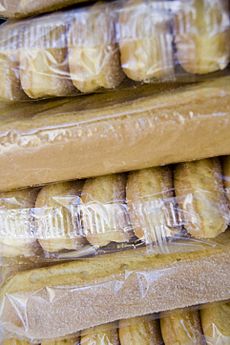Ladyfinger (biscuit) facts for kids

Ladyfingers
|
|
| Alternative names | Savoiardi, sponge fingers, Boudoir |
|---|---|
| Type | Cookie |
| Course | Dessert |
| Place of origin | Savoy |
| Region or state | Piedmont |
| Created by | 15th-century official cuisine of the Duchy of Savoy (may pre-date in vernacular cuisine) |
| Main ingredients | Flour, egg whites, egg yolks, sugar, powdered sugar |
Ladyfingers are light, sweet cookies that look a bit like large fingers. In British English, they are often called sponge fingers. You might also hear them called savoiardi (an Italian name) or boudoirs (a French name). Some people even call them baby fingers because they are soft enough for babies to eat.
These cookies are made mostly from eggs, sugar, and flour. They are dry and have a soft, spongy texture, similar to a light cake. Ladyfingers are a key ingredient in many yummy desserts. For example, they are used in trifles, charlottes, and especially in tiramisu.
Often, ladyfingers are dipped in sweet liquids like sugar syrup, coffee, or even a special liqueur for adults. This makes them even softer and adds more flavor to desserts.
Contents
The History of Ladyfingers
Ladyfingers were first made a long time ago, in the late 1400s. They were created in a place called the Duchy of Savoy, which is now part of Italy. These special cookies were baked to celebrate a visit from the King of France.
Because they were so popular, especially with the younger members of the royal court, they became known as Savoiardi. They were even recognized as an "official" cookie of the court! Visitors were often offered ladyfingers as a tasty example of the local food.
Different Names for Ladyfingers Around the World
Ladyfingers are loved in many countries, and they have lots of different names! Here are some of them:
- In Argentina: vainillas
- In Australia: "sponge fingers"
- In Austria: Biskotte
- In Bosnia, Croatia, and Serbia: piškote/piškoti
- In Brazil: biscoito champagne ("champagne biscuits")
- In Bulgaria: bishkoti (бишкоти)
- In Canada: "ladyfingers"
- In El Salvador: “suspiros”
- In Chile: galletas de champaña ("champagne biscuits")
- In China: shǒuzhǐ bǐnggān (手指饼干, "finger biscuits")
- In Colombia: lenguas ("tongues")
- In Cuba: bizcocho
- In the Czech Republic: dlouhé piškoty ("long sponge biscuits")
- In Finland: tiramisukeksit ("tiramisù biscuits")
- In France: boudoirs or biscuits à la cuillère ("spoon cookies")
- In Germany: Löffelbiskuits ("spoon cookies")
- In Greece: savouayiár (σαβουαγιάρ)
- In Guatemala: chiquiadores
- In Hungary: babapiskóta ("baby sponge cake")
- In Indonesia: kue lidah kucing ("cat's tongue cookies")
- In Iran: latifeh (لطیفه)
- In Israel: biskot (בישקוט)
- In Italy: savoiardi
- In North Macedonia: biskviti (бисквити)
- In Mexico: soletas
- In Flanders and the Netherlands: lange vingers ("long fingers")
- In Pakistan: Bistiks
- In the Philippines: broas
- In Poland: kocie języczki ("cats' little tongues")
- In Portugal: biscoitos de champanhe ("champagne biscuits")
- In Romania: pișcoturi
- In Russia: damskiye pal'chiki (дамские пальчики, "lady's fingers")
- In Slovakia: cukrárske piškóty ("confectioner's biscuits")
- In Slovenia: bebi piškoti ("baby cookies")
- In South Africa: "boudoir biscuits" or "finger biscuits"
- In Spain: bizcochos de soletilla
- In Taiwan: 手指餅乾 ("fingers-cookie")
- In Turkey: kedi dili ("cat's tongue")
- In the United Kingdom: "sponge-fingers" or "boudoir biscuits"
- In the United States: "ladyfingers"
- In Uruguay and Venezuela: plantillas
- In Vietnam: "Bánh Sâm Banh" (Champagne)
How Ladyfingers Are Made
Making ladyfingers is a bit like making other sponge cakes. They don't usually use baking powder or baking soda to rise. Instead, they get their airy, "sponge" texture from air that is mixed into the eggs.
Here's how it generally works:
- The egg whites and egg yolks are beaten separately with sugar.
- Then, these mixtures are gently folded together with flour.
- The dough is put into a pastry bag.
- It's then squeezed out in short lines onto baking sheets, which gives the cookies their famous finger shape.
Before they are baked, powdered sugar is often sprinkled over the top. This creates a soft, slightly sweet crust on the outside. Once baked, these delicious ladyfingers are ready to be enjoyed on their own or layered into your favorite desserts!
See also
 In Spanish: Bizcocho de soletilla para niños
In Spanish: Bizcocho de soletilla para niños



